By Nakadai
A journey begins...
At the age of 16 a friend introduced me to something I never could of envisioned on my own. The epic awesomeness that is Shogun Assassin.
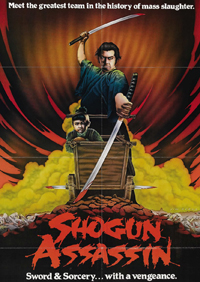
Recently returned from New York City, my friend had happened by an old kung fu bootleg shop. When asking the owner , "What's the craziest shit you've got?". The owner immediately pointed him in the direction of one of many VHS tapes enclosed in a clamshell casing, with poorly printed poster art tucked under the outer sleeve. This one happened to be titled Shogun Assassin. I must admit some days later when my when my friend first handed me the box, I was more interested in the Blunt my brother was hot-boxing to the left of me. Yet shortly after inserting the tape into my old Wizard duel deck VHS player, my eyes became transfixed on geysers of blood spraying endlessly, amongst a whirlwind of blades and fury.
Needless to say, after the initial viewing I become locked into the world of Ogami Itto and his young son Daigoro. Shortly thereafter I quickly discovered Shogun Assassin to be an edit of the first two films of a 6 part series, an English dub had hammily replaced the original Japanese dialog with intermittent English narration's by Daigoro.
So this with this my first introduction to Lone Wolf and Cub, I was inadvertently led directly to the original 6 films starring Tomisaburo Wakayama, and eventually through the years various other adaptations. As much as i've always enjoyed the Lone Wolf series, it actually wasn't until recently that I had the opportunity to read through the Manga in it's entirety, the original source material for the films and central focus of this feature...
In 1970 Kazuo Koike and Goseki Kojima released the first chapter of Kozure Okami (AKA: Lone Wolf and Cub). Koike penned the story, while Kojima would illustrate. When all was said and done Kozure Okami would span 28 volumes, averaging over 300 pages a piece and totaling over 8,000. Epic in every sense of the word.
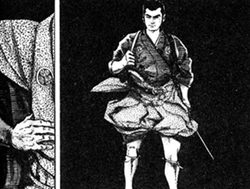 Kozure Okama tells the story of Ogami itto former Kogi Kaishakunin to the Shogun, and his young son Daigoro. The Kogi Kaishakunin was the Shoguns official executioner. Often Bushi (one who follows Bushido) were ordered to commit seppuku to atone for failure. This required the Bushi to cut open their stomach first horizontally, then upward spilling out their intestines. As this was a horribly painfully slow way to die, a second known as the kaishakunin would then step in to deal the final blow severing the bushi’s head to mercifully hasten death.
Kozure Okama tells the story of Ogami itto former Kogi Kaishakunin to the Shogun, and his young son Daigoro. The Kogi Kaishakunin was the Shoguns official executioner. Often Bushi (one who follows Bushido) were ordered to commit seppuku to atone for failure. This required the Bushi to cut open their stomach first horizontally, then upward spilling out their intestines. As this was a horribly painfully slow way to die, a second known as the kaishakunin would then step in to deal the final blow severing the bushi’s head to mercifully hasten death.
The Kogi Kaishkunion was an esteemed position amongst Samurai. Granting him the honor of donning the Hollyhock crest of the Tokugawa. It was considered unthinkable for a Retainer to turn their blade on their lord, thus the Tokugawa’s crest symbolized it was the Shogun himself doing the beheading.
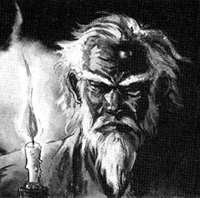
Growing increasingly jealous of Ogami Itto and his status, Yagyu Retsudo, head of the Yagyu Clan plotted to take controll of the positioning of Kogi Kaishakunin for his Yagyu. The Yagyu Clan was split into two factions. The public face which was the military adviser to the Shogun, and the Ura-Yagyu (Shadow Yagyu) who were the Shoguns official assassins, and his eyes and ears through out the 60 states of Japan. It was through these means, that the Yagyu essentially ran all of Japan in the shadow of the Shogun.
In a devious plan to incriminate and shame the Itto family name, the Yagyu secretly place a Ihai(funeral tablet) bearing the Shoguns crest in the Itto family temple. Whilst Ogami Itto is away members of the Yagyu slaughter his wife and servants, leaving only his newly born son Daigoro alive. Itto returns home to the shockingly abhorrent scene, only later to be to confronted by Yagyu officials. The officials claim credit for the murders had been taken by 3 former retainers of an abolished clan, whose lord had been beheaded by Itto. The Retainers had supposedly committed seppuku, leaving a note explaining their actions, and accusing Itto of praying for the death of the Shogun.
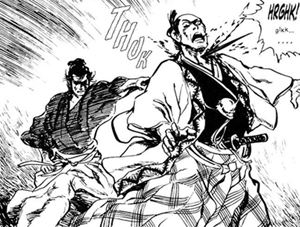
Itto easily sees through the hollow plot to destroy his name slaying the Yagyu officials, including Retsudo's very own son. After dispatching the Yagyu, Itto notices Retsudo watching over in the distance. Itto calls out to Retsudo, only to have Retsudo reply “ Wash your neck and wait!” as he leaves.
Later Itto offers Daigoro the opportunity to choose to remain a child and follow his mother, or take the path of a demon along side his father, and exact revenge for their fallen clan and mother on the Yagyu. Daigoro chooses to follow his father, with their named now wrongfully smeared as conspirators against the shogun father and son set out on Meifumadao (The Road to Hell), taking up as Assassins paving the way for their future revenge upon the Yagyu.
Genuinely speaking, Kazure Okami is an absolute masterpiece. I realize that all too often series' are overhyped, with the content at hand overshawdowed by an inflated reputation. Kozure Okami is an instance where a favorable reputation is more than well deserved, and often understated due to its more exploitable elements and its high profile film and television adaptations.
It's no wonder producer Shintarô Katsu (Zatoichi) sought to bring Kozure Okami to big screen. The manga reads as if it was litterally written to be put to film, undoubtedly inspired by the chambara eiga of Japan. Kojima's highly cinematic illistations, finely detailed with a presence absolutely dripping with emotion under the heavily stylized yet captivating imagery. Kojima's illustrations replace the trappings of needless or the overtly mundane dialog, displaying the intended course with ease. An integeral part of the story is the numberable fight sequences, which under Kojima's revered artisanship flow flawlessly, with a blinding ferocity from panel to panel.
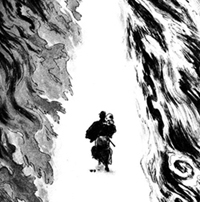
Koike's writings truly humanizes his characters, which could be represented no better than which is the heart of Kozure Okami itself: The relationship of father and son, an inseparable bond of love and vengeance. Nothing can penetrate their love for one another. No blade nor ill intentioned plot can sever that bond, not even death which while under the path of Meifumadao is never but an instant away. Further more the evolution of the relationship between Yagyu and Itto is a tangled meshing of mutual respect and utter distaste, centered into pure rage and despair. The figurative chess match between the two amazingly calculated, with every moved analized and countered in like until the fateful final confrontation. Most every chapter produces new relationships, profoundly reacting to one another and seting forth a chain of events which unravel throughout the entire series. Differing from many giants of the Japanese manga industry, Kozure Okami distances itself from silliness and cheese keeping the serious tone throughout but for the occasional reflective cuteness of Diagoro.
Intermingled amongst the compelling story, characters, action and setting is a wealth of information on the Edo period. Koike went to great lengths researching and making sure that the era was portrayed as accurately as possible, and it shows. Everything is thoroughly detailed and explained, making it not only entertaining but highly informative as well. Kozure Okami fully immerses the reader in the period, potentially heightening the readers interest and surely their enlightenment in Japanese history.
Lone Wolf & Cub is a phenomenal reading experience, with more than enough to offer both those that would or wouldn't normally gravitate toward the Manga medium; and following a going rate up to and around $8 a volume, one can easily test the waters without paying too much out of pocket. Check it out.

Please feel free to discuss "Lone Wolf & Cub Manga" here, in our forums!

